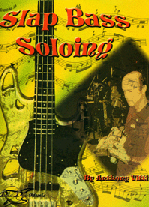DaaDoo Music
Anthony Vitti - Professor - Berklee College of Music
Bass Books
Video Lessons
Groove Yard

Slap Bass Soloing: (eBook w/audio)
The concept of this book is to show the player both a musical and logical approach to creating a slap solo or writing a slap bass line. At the same time I have included some very progressive techniques and put them in lines so you will have ideas of how to apply them. When I hear players solo in this style, it often sounds like they are just wandering, playing licks, or that the solo has no structure. You may have had that feeling at times. I know I have. A solo has to build. On the Bass, we don’t have the luxury of playing long sustained notes, or of using distortion or other effects like guitar players. Add with that the fact that the range of the instrument is not the most exciting and you can see that we have to captivate and hold the attention of the listener in other ways. How do we do it? With rhythm, melody, phrasing and an effective use of the range of the instrument. You will see how I build on a simple idea (simple to some) and then step it up rhythmically, technically and melodically. You will have to develop a strong sound. Not necessarily like mine, but something you feel confident with. Your sound will affect your playing, hearing and creating of lines more than you think. I tried to put combinations of techniques and ideas that will inspire you and show you the potential of what is possible. You may find other ways of getting the same sounds or ideas played than what I have written. That is great, but I want you to play the lines the way I have written them, with the same techniques, before you stray and do things your own way. I did not try to soften this book to make it easy. This is the real thing. Difficult for me and I’m sure difficult for you. This book gets right to the meat and potatoes of some advanced slap playing. Although the exercises are loosely arranged from least difficult to most difficult, there is nothing easy about playing any of these grooves well. I think that’s what players want when they get my books, so I have tried to deliver in this one. Depending on a player’s ability when they get this book, they will find different aspects of it easier than others.
The grooves are set up in eight bar phrases. There are three versions of each idea. The first version is the basic idea. You can think of it as the underlying theme. Sometimes it will be a rhythmic idea and sometimes a melodic idea. Often it will be a combination of both. The focus of one groove may be on the phrasing elements and in another it may be the sheer technical requirements. The point is that I am starting with a basic idea. Usually, just two bars. Then I stretch it out to an eight bar phrase. That is a very important concept. Taking a little material and making a lot out of it. Players sound like they are “wandering” when they are soloing, because there is no structure or strong underlying idea. By taking a two bar phase and stretching it out, you’re not left wondering, “what am I going to play?” Your focus becomes on the feel, execution, consistency and subtle rhythmic variations that you can add. You must get the first version of the groove down, before you move on. I’m trying to show you that you could take a good solo with just the first idea. As you get better and more confident in your technique, you will be able to add more depth to your playing with the concepts contained in the latter versions of that example. Remember that a solo has to build. You can do that with notes, rhythm or range, but it has to build. That’s why I wrote the book this way. Once you get all three versions of a groove down, you can vamp on the first version for a few minutes and then move on to the second and third. This will give you the feeling and concept of developing a groove and building a solo. One of the most important things is to take the stuff slow and be meticulous with your execution. You have to be the judge and jury of your own playing. You have to know if you are sounding good or not. Always play with a metronome or drum machine. I always do.

